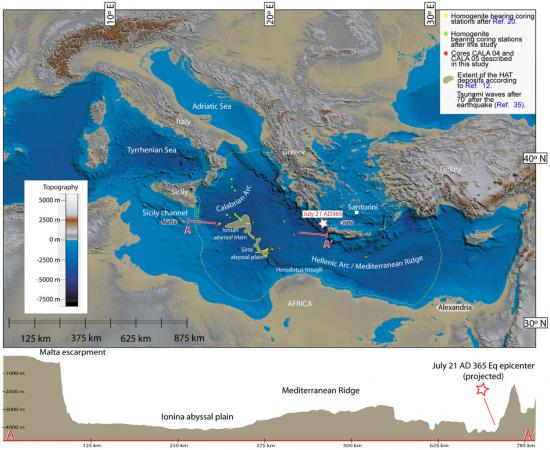CNR publishes study on anomalous wave caused by Crete quake
Source - http://www.ansamed.info/ansamed/en/news/nations/spain/2013/04/01/Mediterranean-sediments-tell-tsunami-365-D-_8486122.html
A powerful earthquake measuring 8-8.5 on the Richter scale 1,600 years ago led to an enormous tsunami in the Mediterranean, according to a recent reconstruction by a team under the scientist Alina Polonia from the Institute of Marine Science (ISMAR). The institute, part of the Italian National Research Council (CNR), has published its findings in the Scientific Reports journal of the Nature group.

Shaded relief map of topography/bathymetry of the central and eastern Mediterranean Sea. Shaded relief map of topography/bathymetry of the central and eastern Mediterranean Sea: Global Bathymetry and Elevation Data from SRTM30_PLUS [Credit: Becker et al., 2009]
The discovery is undergirded by the presence off the Sicilian coastline of a deep sea area of marine sediments measuring up to 25 meters in thickness, at the bottom of which are rough deposits dragged to that depth by the catastrophic force of the currents. The deposits are known as ''Augias homogenite'' or ''Augias turbidite'', and occupy a large part of the eastern Mediterranean. A number of theories had been drawn up to explain their origins: the most highly accredited had been the explosion of the volcano Thera (Santorini) in 1627-1600 B.C. which destroyed the Minoan civilization.
According to the research conducted by Polonia's team, the cause of the enormous sedimentary deposit was instead a tsunami created by a destructive earthquake which hit Crete in 365 A.D. with a estimated magnitude of between 8 and 8.5 on the Richter scale. The work published in Nature noted that the tsunami created was comparable to that which occurred in 2004 in Sumatra, and likely had similar effects in terms of the destruction of the coastal regions. The researchers, reports the CNR website, arrived at their conclusions by analyzing a large amount of geophysical and geological data, including high-resolution acoustic images of the sedimentary deposits and samples of the sediment taken from the deep sea bed at almost 4,000 m below sea level. The discovery was made possible by the precise dating of the deposits and the ascertainment that they had come from several different areas of the Mediterranean. An earthquake and its resulting tsunami can move enormous quantities of sediments, which from the coastal areas end up in the deepest areas of the basin. Shoring up the scientific conclusions are also the words of the Latin historian Ammianus Marcellinus, who documented the devastating effects of a tsunami hitting Alexandria, Egypt, on July 21, 365 A.D. He wrote that over 700 km from the epicenter huge waves had led to widespread destruction and thousands of casualties. Of interest is also the discovery by the researchers of other similar events of larger proportions and dating back further in time. This suggests that the tsunami in 365 A.D. was not the only one in the history of the Mediterranean Sea. ''The time of recurrence inferred from the radiometric analysis, is in any case very high, around 15,000 years,'' said Alina Polonia. (ANSAmed).